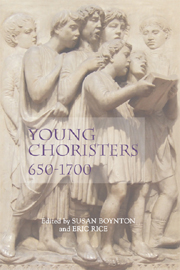Book contents
- Frontmatter
- Contents
- List of Illustrations
- List of Musical Examples
- Acknowledgements
- Dedication
- Introduction: Performance and Premodern Childhood
- 1 The Boy Singers of the Roman Schola Cantorum
- 2 Boy Singers in Medieval Monasteries and Cathedrals
- 3 The Musical Education of Young Girls in Medieval English Nunneries
- 4 Choirboys in Early English Religious Drama
- 5 From Mozos de coro towards Seises: Boys in the Musical Life of Seville Cathedral in the Fifteenth and Sixteenth Centuries
- 6 The Seeds of Medieval Music: Choirboys and Musical Training in a Late-Medieval Maîtrise
- 7 Choirboys in Cambrai in the Fifteenth Century
- 8 Choirboys and Vicaires at the Maîtrise of Cambrai: A Socio-anthropological Study (1550–1670)
- 9 Choirboys, Memorial Endowments and Education at Aachen's Marienkirche
- 10 Thomas Mulliner: An Apprentice of John Heywood?
- 11 Cantando tutte insieme: Training Girl Singers in Early Modern Sienese Convents
- 12 Choirboys in Early Modern Rome
- General Bibliography
- Index
3 - The Musical Education of Young Girls in Medieval English Nunneries
Published online by Cambridge University Press: 12 September 2012
- Frontmatter
- Contents
- List of Illustrations
- List of Musical Examples
- Acknowledgements
- Dedication
- Introduction: Performance and Premodern Childhood
- 1 The Boy Singers of the Roman Schola Cantorum
- 2 Boy Singers in Medieval Monasteries and Cathedrals
- 3 The Musical Education of Young Girls in Medieval English Nunneries
- 4 Choirboys in Early English Religious Drama
- 5 From Mozos de coro towards Seises: Boys in the Musical Life of Seville Cathedral in the Fifteenth and Sixteenth Centuries
- 6 The Seeds of Medieval Music: Choirboys and Musical Training in a Late-Medieval Maîtrise
- 7 Choirboys in Cambrai in the Fifteenth Century
- 8 Choirboys and Vicaires at the Maîtrise of Cambrai: A Socio-anthropological Study (1550–1670)
- 9 Choirboys, Memorial Endowments and Education at Aachen's Marienkirche
- 10 Thomas Mulliner: An Apprentice of John Heywood?
- 11 Cantando tutte insieme: Training Girl Singers in Early Modern Sienese Convents
- 12 Choirboys in Early Modern Rome
- General Bibliography
- Index
Summary
It is requested that those who are to be received as nuns will be taught and instructed in reading and singing before they are admitted.
(From a nun's comment at the visitation to Burnham Priory, Diocese of Lincoln, 1520)SOURCES from medieval England make it abundantly clear that the primary requisite skills for each nun are the ability to read and to sing. Nuns themselves, as evidenced in the above citation from visitation records, emphasized that new nuns should be able to participate fully in monastic life and do their share of the convent's work – matters of deep concern for them. Yet the processes through which nuns mastered these skills are considerably less clear. Evidence from a variety of primary and secondary source materials shows that throughout the Middle Ages, despite the increasing availability of written materials, instruction in liturgical music for English nuns continued to flourish within a culture of oral transmission, memorization of vast quantities of chant, and the gradual absorption of each young woman into the nunnery.
Reading in the medieval period was much more an oral/aural experience than a visual one and relied on the individual's development of great stores of memorized material. At a minimum, a nun was able to recognize the letters of the alphabet and sound out basic syllables, and had learned to read the Psalter – learning also implied reading aloud and memorizing.
- Type
- Chapter
- Information
- Young Choristers, 650–1700 , pp. 49 - 67Publisher: Boydell & BrewerPrint publication year: 2008



